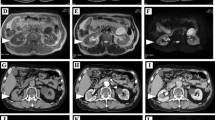Summary
Twelve renal cell carcinomas composed of “chromophobe” cells are described. This is the first report of renal chromophobe cell tumors in humans neoplasms of this cell type having been described previously only in experimentally induced adenomas in animals.
By light microscopy chromophobe cells have slightly opaque or finely reticular cytoplasm when stained with haematoxylin and eosin. They may be distinguished from the clear cells of hypernephroid renal cell carcinomas by the strongly positive reaction of their ctyoplasm with Hale’s (1946) colloidal iron method and the weaker positive reaction with alcian blue. Vesicular structures, often containing internal vesicles, and possibly derived from the endoplasmic reticulum or from mitochondria are visible electronmicroscopically. Glycogen is present to a variable but slight extent so that it is usually detected only by electron microscopy.
The twelve renal cell carcinomas described were composed entirely of chromophobe cells. They were derived from a series of more than 500 adult renal cell carcinomas giving a frequency of approximately 2%. To avoid confusion the descriptive term “light cell” should be discarded and replaced by either “clear cell” or “chromophobe cell” as appropriate, since it is assumed that chromophobe cell tumors have a different derivation from clear cell and other renal cell carcinomas. They may also have a different prognosis although this has not yet been established.
Similar content being viewed by others
References
Apitz (1943) Die Geschwülste und Gewebsmißbildungen der Nierenrinde. III. Die Adénome. Virchows Arch [Pathol Anat] 311:328–359
Bannasch P, Schacht H, Storch E (1974) Morphogenese und Mikromorphologie epithelialer Nierentumoren bei nitrosomorpholin-vergifteten Ratten. I. Induktion und Histologie der Tumoren. Z Krebsforschung 81:311–331
Blessing MH, Wienert G (1973) Onkozytom der Niere. Zentralbl Allg Pathol Anat 117:227–234
Burck H-Chr (1983) Histologische Technik. Thieme Verlag, Stuttgart
Hale CW (1946) Histochemical demonstration of acid mucopolysacharides in animal tissues. Nature 204:745–747
Hamperl H (1962) Benign and malignant oncocytoma. Cancer 15:1019–1027
Lieber MM, Tomera KM, Farrow GM (1981) Renal oncocytoma. J Urol 125:481–485
Luna LG (1960) Manual of histologic staining methods of the Armed Forces Institure of Pathology. 3rd edition. Mc Graw Hill Book Company, New-York Toronto London Sydney
Masson P (1923) Les tumeurs. Paris: A maloine
Reynolds ES (1963) The use of lead citrate at high pH as an electronopaque stain in electron microscopy. J Cell Biol 17:208–213
Walt JD van der, Reid HAS. Risdon RA, Shaw JHF (1983) Renal oncocytoma. Virchows Arch [Pathol Anat] 398:291–304
Zippel L (1941) Zur Kenntnis der Onkozyten. Virchows Arch [Pathol Anat] 308:360–382
Zollinger HU (1966) Niere und ableitende Harnwege. In: Doerr H, Uehlinger E (eds) Pathologische Anatomie, Band 3, Springer, Berlin Heidelberg New York
Author information
Authors and Affiliations
Rights and permissions
About this article
Cite this article
Thoenes, W., Störkel, S. & Rumpelt, H.J. Human chromophobe cell renal carcinoma. Virchows Archiv B Cell Pathol 48, 207–217 (1985). https://doi.org/10.1007/BF02890129
Received:
Accepted:
Issue Date:
DOI: https://doi.org/10.1007/BF02890129




